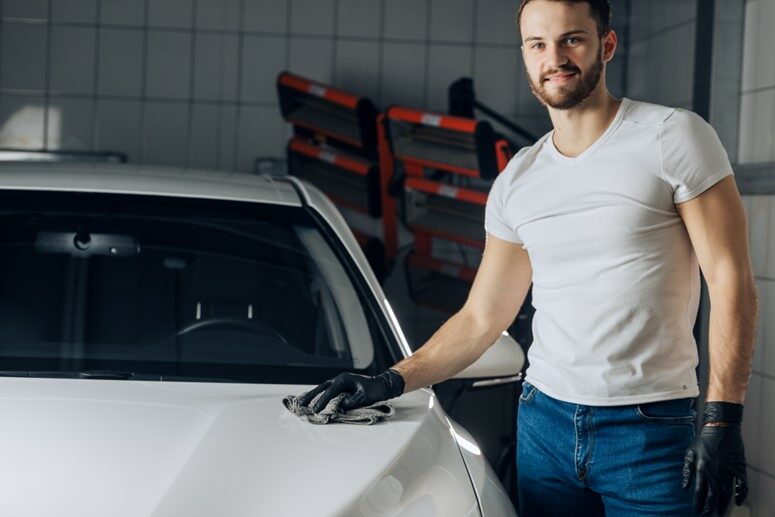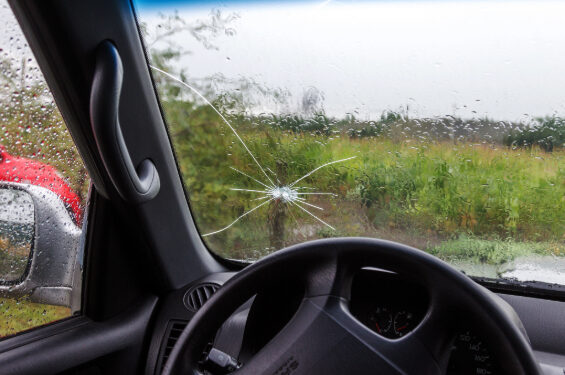
If you just bought a new car or had it painted, you want to keep it looking new for as long as possible. Waxing your car can be very beneficial to maintaining that fresh look.
What is Car wax? And what does car wax do?
Car wax, or automotive wax, can be natural or synthetic and is designed to protect the body parts of a vehicle and enhance the paint’s shine. [1]
Waxing your car is a great way to keep it looking sharp, but did you know it has many more benefits? In addition to giving your car a beautiful shine, waxing helps by:
- Protecting the paint from airborne contaminants and the elements. By forming a protective coat, it prevents corrosive elements (such as salt or tar) and bugs from becoming embedded in your paint.
- Preventing paint chipping. It also slows the effects of smog, wind, rain, and sun on your finish.
- Filling in scratches. While you can’t remove minor scratches from your car by waxing, you can help make them less noticeable.
- Expediting the car-washing process. Without a coat of wax, it’s harder to remove impurities like bugs, sap, and other unwanted substances that can collect during your daily drive.
What are the different types of car wax?
Waxing your vehicle will make it shine and protect the finish from various environmental hazards, mainly birds, tree droppings, and pollutants. There are plenty of car wax types on the market; here are the pros and cons of each. [2]
Liquid wax
Liquid wax is the best for cleaning, gloss, and durability, but it’s somewhat challenging to apply. Some liquid waxes are also slightly abrasive, which could damage your car’s finish.
Paste waxes
Paste waxes are very easy to apply, but they tend to lose their luster sooner than liquid waxes. It may also contain abrasive components, so be careful when applying it to your car.
Spray waxes
Spray waxes work well for the paint on newer cars and are the quickest to apply, but they do not last as long as a liquid wax. In addition, spray waxes are typically nonabrasive.
Check with the dealership where you purchased your vehicle or the shop that painted it to get recommendations on which type of wax would be best for your vehicle’s finish and the environment you will be driving in.
How often should you wax your car?
To reap the benefits of waxing, you’ll need to maintain a regular schedule. Waiting until it looks like a fresh coat of wax will make your vehicle more vulnerable to small chips and fading paint.
Just as you have a regular maintenance schedule for your engine, it’s essential to have a regular schedule to maintain the exterior. How often you wax can depend upon several factors, including:
- How often you drive your vehicle
- Whether it’s parked in a garage or out in the open
- The type of wax you use
If you want that fresh-from-the-showroom-floor look, some experts recommend you wax your car about once a month. Some of the newer synthetic waxes on the market claim they can keep a showroom-worthy shine for up to a year; others say every three months is sufficient.
One way to tell it’s time to wax your car is to see if water beads on the surface when it’s wet. If not, it’s time for a new coat of wax. [3]
How to properly wax a car
The easiest way to get a super shine is to go to a car wash that provides a professional wax service. But you can also do it yourself and get fantastic results. An electric polisher will make the job easier and faster, but you can also do it by hand and get a beautiful finish.
How to Wax a Car by Hand
- Wash your car.
- Apply the appropriate kind of wax.
- Work in sections and rub in the wax using polishing pads. [4]
How to Wax a Car with a Buffer
- Wash your car.
- Apply the appropriate kind of wax for a mechanical buffer.
- Buff in the wax, being sure to follow the instructions for your mechanical buffer. [4]
Car Waxing Tips
Keep these tips in mind for the best results:
Prep for your wax with clay
A clay bar is used as part of the cleaning process before waxing. Even after a thorough wash, your vehicle will still have some gunk embedded in the finish — which is where clay bars come in. Used with a lubricant, a clay bar grabs these particles out of the finish. As with the waxes, there are various levels of abrasiveness with clay bars, and you need to make sure you use one suitable for your vehicle’s finish.
Once you have “clayed” your vehicle, you can apply a fresh coat of wax to keep other contaminants out. While waxing cannot make your old car look new, it can protect the finish of a new or newly painted car for years to come.
Always wax your car in the shade
Try to wax your car under a protective cover, such as a carport, tent, or other structure. On a sunny day, your car can become hot, and when you apply wax to the hot surface, the wax will dry quite quickly. This makes it more difficult to remove.
Another reason to wax under cover is the possibility of bad weather. The wax can’t adhere properly to the surface of a wet car and can create a sloppy mess. It can also run off the body of the car and get on the molding and plastic parts, which can be a pain to remove. [5]
Apply wax to small sections
Complete each section before moving on to the next to avoid having the wax dry. Adding more wax will not give you a better shine; it will just make it harder to buff the wax off. If you want more shine, add another coat, but check the label to see how long the first coat should be allowed to dry before applying the second one.
Make friends with microfiber
These are the best towels for polishing your car because they don’t leave behind lint and are great for buffing. Be sure to have plenty of towels on hand, so you’re not using a wax-caked towel.
Use a soft brush for gaps and molding
Keeping a soft brush handy while waxing your car can help get wax off molding and out of cracks. You can buy these brushes at most auto parts stores, which are typically inexpensive. Removing wax from a car’s molding after it’s dry can be tricky, and sometimes the wax will leave permanent staining. Instead, use a soft brush to remove wax from moldings or cracks before it dries to help avoid permanent staining.
Use a random orbital buffer
Waxing your car with a mechanical buffer can save time and effort, making waxing your car a breeze. Many people prefer rotary buffers; however, they spin in a circular motion at a high velocity, which can cause permanent “burn” marks from the edge of the pad digging into the paint. Rotary buffers can also cause swirl marks due to the pad becoming dry and making micro scratches in the paint.
To help prevent this, use a random orbital buffer, which moves the pad in a random pattern rather than circular. This results in an even application of wax without the risk of creating damaging marks. Both the rotary and random orbital buffers are similarly priced. [5]
How long does car wax last?
In each case, the time and care you spend waxing your vehicle will translate into how long the job will last. If you are willing to spend the time and elbow grease, you can expect your shine to last up to 3 months. A general rule of thumb is to wash your vehicle weekly and wax it every 8 to 12 weeks. [3]
Waxing your vehicle is a great way to ensure it stays shiny and looks great. Waxing helps protect your car’s paint from damaging sun rays, abrasive dirt, and chemicals in the rain and snow. Proper, regular waxing can extend the life of your car’s paint and help keep your vehicle looking sharp long into the future.
For more tips on keeping your car in mint condition, discover cleaning tools every car owner should have.
Sources:
[1] “The Truth About Car Wax: 9 Things You May Have Overlooked!” avalonking.com/blogs/guides/the-truth-about-car-wax (March 28, 2019).
[2] “How Car Wax Protects Your Car’s Finish,” turtlewax.com/blogs/how-to/how-car-wax-protects-your-car-s-finish (accessed Dec. 8, 2022).
[3] “How Often Should You Wax Your Car?” Jessica Shea Choksey, jdpower.com/cars/shopping-guides/how-often-should-you-wax-your-car (Dec. 18, 2020).
[4] “How to Wax a Car by Hand or with a Buffer,” Chloe Murphy, leasefetcher.co.uk/guides/car-maintenance/how-to-wax-car (Aug. 26, 2021).
[5] “How to Wax Your Car with Amazing Results: 7-Step Guide,” driving-tests.org/beginner-drivers/how-to-wax-your-car/ (accessed Dec. 9, 2022).
Disclaimer:
| The information included here is designed for informational purposes only. It is not legal, tax, financial or any other sort of advice, nor is it a substitute for such advice. The information may not apply to your specific situation. We have tried to make sure the information is accurate, but it could be outdated or even inaccurate in parts. It is the reader’s responsibility to comply with any applicable local, state or federal regulations. Nationwide Mutual Insurance Company, its affiliates and their employees make no warranties about the information or guarantee of results, and they assume no liability in connection with the information provided. Nationwide and the Nationwide N and Eagle are service marks of Nationwide Mutual Insurance Company. © 2023 Nationwide |



